|
:: [Part 2:
Stanley Steamers and
Yorkshire Steam Wagons in 1908 Philippines.]
::
The answer to Leslie Ann Murray of the American Chamber of
Commerce had been given and this article on the general background to De
Dion-Bouton relating to the supply of commercial vehicles for the
infamous Kennon Road in the Philippines Mountain Province had been forwarded
to her. The conclusion was that her photos related to De Dion-Bouton
vehicles not
of 1908 but of those delivered after 1910 and that this was quite a few years
after Kennon Road had been opened. It was also concluded
that De Dion-Bouton vehicles were ordered because of their international
reputation as reliable mass-transport vehicles, tried and tested in many
capital cities and in the European Alps. So, - that was it; - end of story.
Fascinating question about a long gone make of vehicle in a very far-away place. Done and dusted !
However, despite having given the answer to the specific question asked,
I was left with one large nagging question. If Kennon/Benguet Road was completed in 1905/6, what, if anything, was used to transport
the people from the base to Baguio City in the four years until 1910?
The nagging continued as did the desire to fill the 'missing
link'; - and so the research continued. (Shades of becoming an
anorak!) Then a chance click on a Philippine website via a Philippine
search engine found tucked away in amongst current information on a
tourist company website about Baguio City, a short statement:
" ...Beginning 1909, a government fleet of Stanley steam
autos brought up more than 2,000 passengers a season."
Now here was a turn-up for the books! We knew that a fleet of vehicles
was used and that they were De Dions, so this surely had to be an error.
Further research on Philippine sites produced no other mention of
Stanley Steamers, and all further
international web research on Stanley Steamers produced no mention of
any of them having been used in the Philippines.
So contacts were renewed with Leslie Ann to see if she had any further
information. She confirmed the road was under construction in 1905 and
there were problems in finishing it due to the final gradient being
nearly a sheer wall. The road was originally called Benguet Road as it
led into Benguet Province in the Cordillera mountains of Luzon, the
chain of mountains in the centre of the island. She also confirmed that
the road was eventually named after a Major Kennon the U.S. Army
engineer who figured out how to get the road up the mountain by building
the road in a zigzag up the incline (still formally known as the Zig-Zag).
But nothing about Stanley Steamers.
So I contacted the Stanley Museum in Kingfield, Maine, USA, and asked
advice if they knew of any Stanleys having been supplied to
the Philippines. I was pleased to receive a reply from their Archivist
Jim Merrick who advised that their records indicate that a
"fleet" of Stanley steam cars was introduced into the
Philippines during the administration of W. Cameron Forbes, the US
Governor-General of the Philippines from 1909-1913. Stanley Museum
however had no information on where these cars were deployed and were
keen for further information. They provided a photo from their archives
showing a pair of cca 1908/9 Stanley cars in service in the Philippines but
they did not
know where. The cars are both early Stanley nine passenger Mountain
Wagons. It was possible that man in
the pith helmet was W. Cameron Forbes, and the car on the
left had an intriguing address "
B....sts and Philippine Islands" printed on the side.
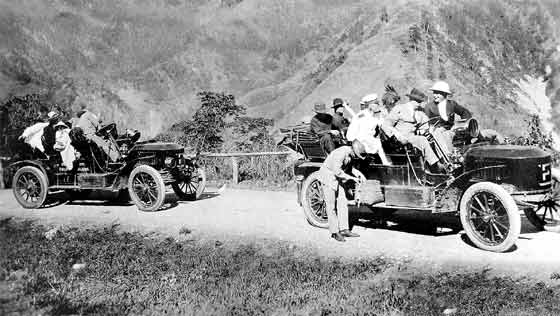
Photo: ©
The
Stanley Museum, Kingfield, Maine, USA
The 'where' bit was easy to determine. The 'colour'
and the background of the mountains and the style of the road indicated
that the photo could not have been taken anywhere else but Kennon Road.
The photos of the De Dions in Part 1 of this article have an identical background. So it
seems that Stanleys must have been up Kennon Road and must have
carried multiple people. This exciting find was emailed to the
Philippines for confirmation of location. This was confirmed as Benguet
Road showing the southern flank of Mt. Santo Tomas in the background,
with the cars having just climbed the steepest gradients of the ZigZag.
In the meantime Leslie Ann had been doing her own researches back in the
Philippines and had contacted Jim Halsema who was the son of the
Mayor of Baguio between 1920 and 1937. Jim is a former news
correspondent, historian and writer/lecturer, now retired and
living in the USA. Jim started delving through his records and with the
assistance of his colleague Erlyn Alcantara they were able to provide some
interesting answers.
It seems that the main proponent for the development of Baguio City into
the official hot season capital of the Philippines was William Cameron
Forbes. Forbes was born into one of the wealthiest USA families in
Boston, went through Harvard and became a partner in the family
business. Wealthy but bored, he originally came to the Philippines in 1904 as the
member of the Philippine Commission for Commerce and Police, with
responsibility for all government-sponsored construction. Here he
discovered that Benguet Road had been built at enormous expense but to little effect because the area lacked
facilities. He was therefore instrumental in the creation of the Baguio
Country Club, encouraged the U. S. Army to establish Camp John Hay (as a
rest and recuperation facility for military personnel in the islands, to
avoid the long sea voyage home), and
created the residence of the Governor General, naming it "The
Mansion House" after the Forbes family summer home off Cape Cod.
It seems that construction of Benguet Road by Major Kennon may not have
been as much of a success as was made out at the time. It was enormously
expensive and took nearly five years to complete and, having
been built separately from both directions simultaneously, did not meet
as expected. This resulted in the construction of the serpentiney 'ZigZag'
which taxed the men and animals constructing it and limited the vehicles
that could be used on it afterwards. It is said that while Cameron
Forbes initially admired Kennon's work he seems to have changed his mind
and quietly transferred Kennon out of the Philippines. The road was
later named, and remains, 'Kennon Road' after Kennon, but not until 1921.
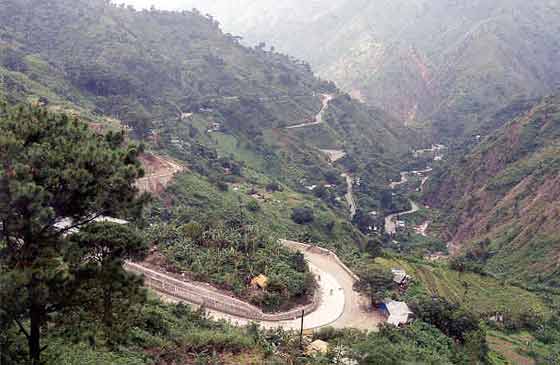
Kennon/Benguet Road had been constructed using manual labour and with local
bull carts and mule drawn wagons. On completion, the Bureau of Public Works began
public transportation on Benguet Road by operating a horse and mule-drawn "stage coach line" familiar
to viewers of Western movies. Very slow and cumbersome but relatively
effective.
In 1905 Cameron Forbes bought to Manila an Insular Architect together
with a young Warwick Greene, son of the general who led American troops
into Manila, as his assistant. Their duties were to implement the Burnham
Plan of urbanising Baguio. Cameron Forbes took the opportunity to be one
of
the very first to build a residence on the highest plateau which
the plan called "Topside". This house, called TipTop, became
the centre of his life and symbolized his commitment to the new
resort.
Young Warwick Greene displayed such imagination, initiative and
mechanical skills that Forbes put him in charge of all phases of
creating the government centre of offices and residences for personnel
transferred during the tropical summer months of March, April and May from Manila. One of Greene's first
preoccupations was to transform the mule-pulled wagon line into an
effective road transportation system to Baguio from a new spur of the
Manila-Dagupan Railroad along the Benguet Road. Without this,
the development of Baguio would not have been possible.
Greene and the Bureau of Public Works were convinced that motorised
vehicles would be necessary but the severity of the inclines limited the
choice. There were some motorised vehicles in use in the Philippines
including some steam propelled wagons. Some vehicles were used in other
road construction projects including 'corduroy roads' where logs were
laid horizontally over the earth, but for Benguet Road they would need
something powerful and relatively quick.
It seems the first choice had been Stanley Steamers, probably chosen
because of their reputation as hill climbers. Stanley Mountain Wagons
were designed to order and used for carrying passengers and freight to
resorts in the White Mountains of New England and in the Rocky Mountains
in the Western U.S. By this time, Cameron Forbes was Vice Governor,
and year later became the Philippines Governor-General, remaining so
until 1913. It is believed that Cameron Forbes may have influenced the choice of
Stanley steam driven cars to be tried in the Philippines because he
would have been aware of them as they were manufactured in the Boston area
where his
family home was located. What is certain, is that the Philippines Commission
authorised the Bureau of Posts to order the first two Stanleys in 1908. These
two Stanleys were operated by the Bureau of Posts
and served two purposes; to provide mail services and to serve as an
experiment for passenger services. The experiment proved successful. The
savings derived from mail transportation augmented by the additional
income from passenger service made it a highly favorable venture.
This resulted later in 1908 in Warwick Greene ordering five
eight-passenger Stanley automobiles for the Benguet Auto Line road service. It is believed that the actual order for the
vehicles was placed by William Greene at the Stanley factory on one of his
periodic visits to his home in Rhode Island. In March 1909 the Benguet Auto Line
began serving Baguio-bound passengers with motorised transport.
Passengers would transfer from the Dagupan railhead to a branch
line that took them to the lower end of the Benguet Road at Camp One.
Here the Stanleys waited to take the
passengers and freight up Benguet Road and the ZigZag to Baguio.

Photo: ©
The
Stanley Museum, Kingfield, Maine, USA
Armed with the above information, examination of the Stanley Museum photo starts to give up
some of its secrets. The most likely date of the photo would be on the turn of 1908/9.
The Wagon on the right was launched by Stanley in June
1908. Study of the writing on the left car, " B....sts, Philippine Islands",
is now quite evidently Bureau of Posts. As the location is Kennon Road
it can only be before the Benguet Auto Line took over. So the photo is
probably of the first two original Stanleys sent to the Philippines. It
has been suggested that the driver might be Warwick Greene with Forbes
beside him in the pith helmet .

© Jaime F. Tiongson (Philippines) obtained from the US Archives showing
President William Howard Taft (Secretary of War at that time) and
Governor General Cameron Forbes
The history of the Stanley Brothers and the development of the Stanley
Steamers is well documented in the John F. Katz' article, "F.E.
& F.O. Stanley: the Challenge from Steam," Automobile Quarterly
25:1, pp.14-29 (1987). A fascinating historical coincidence relating to
this story according to the Stanley Museum is that the Stanley twins
were seemingly inspired to design and build their own motor carriage in
the summer of 1896 following their visit to the Brockton (Massachusetts)
Fair. There they appear to have witnessed a less than impressive
demonstration of an early 'internal combustion' French vehicle which
broke down on the local race track. This vehicle is thought to have been
an early De Dion-Bouton. According to legend, one of F. E.
Stanley's companions asked him if he was going to buy one of the French
cars, and he demurred, saying that he thought he could build a better
one himself. The following year, in 1897, the first Stanley steam car
made its road test.
Stanley Museum subsequently found some more interesting photos in their archives
relating to Stanleys in Baguio. The photo on the left is of a
Stanley touring car. The street sign beside it states "Outlook
Drive". Outlook Drive still exists in Baguio and leads to Baguio
Country Club Road and onwards to Ambuklau Road, the road to 'TipTop',
the Forbes former Baguio residence. The handsome car on the right is possibly a Model F Touring Car which has the monogram CF on
the rear passenger door. This has all the appearances of having been Cameron Forbes' Governor General car.
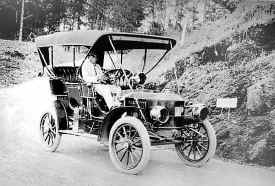
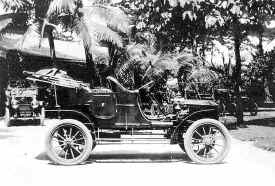
Photos: ©
The Stanley Museum, Kingfield, Maine, USA
It seems that as many as 40 Stanley Steamers may have been introduced
into the Philippines during the times of Cameron Forbes and William
Greene. Certainly a photo from Stanley Museum shows a row of cars in
Manila of which 5 are Stanleys of cca 1910. It is believed that some of
these were used on other road construction programmes. The photo on the right from
the Historical Collection, Ateneo de Manila University shows a Stanley of 1910 vintage bedecked with
bunting and flags leading a car parade. A very faint handwritten date on
the photo suggests July 1911, possibly US Independence
Day?
.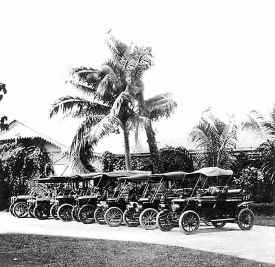
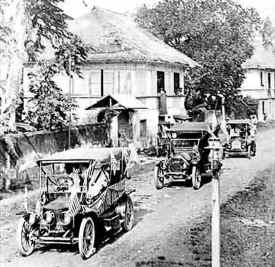
What is interesting to note from Jim Halsema is that by the mid 1920s,
Stanleys seem to have disappeared from general use in Baguio. This may
well have been because they required a lot of water, especially in
difficult terrain, and that adequate supply of water has always been,
and remains, a problem in the city. Stanley Brothers stubbornly resisted adding
condensers to their cars until 1915 because they disliked adding weight
and complexity. It seems
that the Bureau of Public Works experiments with Stanley sedans during
1908-10 had proved the feasibility of mass transport by motor vehicles
along the Benguet Road but it seems that the Stanleys were considered neither big enough nor powerful
enough, so something larger had to be found.
Records have now been found to show that this was the De Dion-Boutons
already described in Part 1 of this article. The first fleet of eight De Dion-Bouton Busses for the Benguet Auto Line
was ordered in 1910 by William Cameron Forbes. What is very
pleasing from my own personal point of view was the
confirmation of my assumption that the De Dion-Boutons could NOT have
been delivered before 1910 and that something must have been used first,
as indeed the Stanleys were.
As a summary to this article,
the following are some excepts from the journals of William
Cameron Forbes, then acting Governor of the Philippines: (April
28, 1908) At Camp One we were met by [Director of Public Works
Warwick] Greene, grim and grimy. He has been working himself to death to
make this transportation plan a success. His different chauffeurs have
failed him and, supported only by the ubiquitous Pedro, he has alone
upheld the day, running three machines himself. Seven times over the
road on Sunday is enough, and working at night besides. But he's turned
the trick, and everyone is full of praise of his result. Twice since
I've been here he's been up at 3:00 a.m. and kept nearly continuously at
it until 1:00 a.m. the next morning, which is more than flesh and blood
can stand, as the road isn't in too good condition, the bridges are
pretty rickety, and I have arranged to have the suspension bridges all
replaced with steel ones. The trip from Twin Peaks to Baguio is not
infrequently made in an hour and ten minutes, and Sundays the crowd is
fierce. There is a scramble for the machines and clamoring...when the
many are left and the few steam out. We are figuring now on buying some
large machines and running a better and more regular service next
year. ... (March 11, 1909) Greene has got some
splendid new machines for the Benguet road, three seats, three to each
seat and he has gone up [to Baguio] to open the new service about a week
ahead. It takes more skill to handle such a big machine on the road, and
the Filipino drivers have to be trained to handle the new service. The
new machines are a great success. They take two hours to a trip,
although Greene has brought them down in one hour and ten minutes. A new
device of brakes has done wonders in this respect--a series of wooden
blocks that can be replaced as fast as worn down. It takes four minutes
to put in a wholly new set. There are fine big garages at either end of
the line. It looks like business, and people are much pleased.
..and some excepts from Philippine public records :
(Fiscal year 1912: BPW, Baguio
Division, Operation of the Benguet Automobile Line.) " During this year this line carried over 19,000 passengers
without accident or injury to any of them. Considering the conditions
under which this automobile service is maintained, this result is
considered remarkable, and may be attributed to the strict discipline
maintained, and to following railroad practice in running automobiles in
trains and regulating the traffic by a regular block system, with passing points at the
gates,
gate-keepers and telephones. The main reliance of the line is placed on
18 trucks, of which 17 were specially built by the well-known De Dion-Bouton firm for service on the Benguet Road, and one by the same firm
for use in Baguio as a bus. These cars have given splendid service, and
leave nothing to be desired as passenger carriers. As freighters,
however, they only carry 2 tons useful load, the design being limited to
this load owing the fact that at the time the cars were ordered, the
weight limits of the bridges on the Benguet Road was 6 tons, and the De
Dion, with full load, driver, helpers, equipment, etc., weighed over 5
tons. The weight limits of the bridges on the Benguet Road has since
been increased to 8 tons, and we are now contemplating the purchase of
heavier motor trucks along somewhat different lines. During the year,
5,161 tons of 2,000 pounds each were carried under the direction of the
automobile line, for the greater part by the De Dion trucks, although a
portion by bull carts and mule teams. A new garage was built near the
electric light plant.
(Quarterly Bulletin,
Bureau of Public Works Jan. 1, 1913.) Extract from Japan Advertiser,
Tokyo, Japan, of a tour of the world made by Mr. Melvin A. Hall of New
York : " With the exception of a few mountain trails the Benguet Road
furnishes the sole communication with Baguio, and everything from
first-class passengers to building material that enters or leaves the
summer capital is carried by the most remarkable automobile service in
the world. A train of high powered De Dions running on a railroad
schedule, makes the return trip daily from Baguio to Camp One,
connecting with the Manila trains. When, as at the time of my visit, the
branch railway line to Camp One was washed out, the motors go 25 miles
further to Dagupan and back, making the round trip nearly 100 miles. We
pulled away from Camp One with our regular place in the train and ran up
the narrow Bued River Canyon, while a little white tag bearing our
number moved on its own wire across the huge score board in Baguio,
which keeps track of every vehicle on the road..."
(Excerpt from: Erlyn Ruth Alcantara, "Building the Benguet
Road," ms, October 1998.) Sample schedule of a trip from Manila to
Baguio at around 1912: " Leave Manila on board the narrow-gauge European-style train of the
Manila Railroad Company at 8 am, served breakfast and lunch aboard the
dining car. After a hot and dusty trip, reached the Dagupan railhead
at 1:30 pm. Changed to a branch line at San Fabian for Camp One. From
the station at Camp One, transferred to a passenger motorbus of the
Benguet Auto Line for a slow three hour climb on the narrow Benguet
Road, stopping every now and then to wait for the "down"
traffic to receive dispatches on the road ahead."
So there you have it; all i's dotted and t's crossed. The end of the story? Surely? Would be,
- but for the little snippet:
(Annual
Report of the Director of Public Works – July 1, 1913-Dec. 31, 1914)
The automobile equipment assigned to the Baguio office included the 18
De Dion cars with 4 trailers and 8 Yorkshire steam wagons with 4
trailers....."
Yorkshire Steam Wagons? Oh no! What are these, ..and what
were they doing in the Philippines?
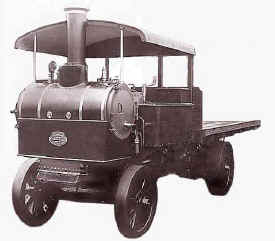
As this article is getting overlong anyway, I will
leave others to do the research on the Yorkshire, and the 'why'. I
can, however, give them a start by saying that Yorkshire Steam Wagons were
manufactured in Hunslet, Leeds, in the county of Yorkshire in England.
So how come English steam lorries found their way to the
Philippines? Well it could have something to do with the fact that the
British owned the Manila Railroad !
ADDENDUM JANUARY 2019
In January 2019 we were contacted by Karen A.
McClure who advised: "My mother, Dorothy Robertson Arwe,
received a call last weekend from an individual who maintains a Stanley
Steamer registry. This gentleman, Kelly Williams, has a photo of my
grandfather, Ellis Robertson, in one of the SS's that was owned by our
family - photo was taken in 1955 at a SS event in Lakeville,
Connecticut. According to Mr. Williams, this vehicle is now owned by the
Automobile Museum in Tallahassee, FL.
I was doing a little online research to learn more about Stanley
Steamers yesterday and found your web site and the information you have
been able to gather on SS's in the Philippines. You may be interested to
know that my mother's grandfather, George Bryant Robertson of Keene, NH,
became an agent for Stanley Steamers in 1904. In 1908 he was invited to
the Philippines as Superintendent of Automobile Service for the
Philippines and to help develop/offer transportation via Stanley
Steamers from Manila to Baguio due to the Stanley Steamer's ability in
travelling steep and rough terrain. He made the trip to the Philippines
alone, and later my great grandmother followed with their four young
children including Ellis, my grandfather. Following the planned one-year
assignment, George stayed an additional year to help repair road damage
caused by a 1909 typhoon. The family returned to New Hampshire in 1910.
I've included information gathered from the archives of The Keene
Sentinel, the local newspaper:
In 1908,
George B. Robertson was chosen by the federal government to go to the
Philippines to manage an automobile line which ran along a short
mountainous government highway to the end of a short railroad leading
from Manila. His official position was Supt. of automobile service for
the Philippines under the bureau of posts. . . .
. . . . George B. Robertson will complete arrangements in a few days to go to
the Philippine Islands for a year, for the US Gov't , to take charge of
a line of Stanley Steamers, running from the end of a railway line from
Manila up the mountains to Bageo, the summer capital of Luzon. Bageo is
situated high up on the mountain and there the Americans in Manila find
relief from the tropical and enervating climate of the capital which
they require for a portion of each year, at least, or when overtaken by
sickness. There is a railway running toward Bageo some twelve miles from
the city of Manila. The ascent to the summer city then becomes so steep
that it cannot be negotiated by a railway of the ordinary type, and no
road like the mountain-climbing line up Mt. Washington has yet been
built. To ascend the last 18 miles of the journey to Bageo with bullocks
or mules is an all day undertaking and a tedious one at that. The sick
are carried up the government road by such primitive means as were at
first afforded only with the greatest difficulty. The government has
built a road at much expense which zigzags up the mountains like the
switch-back lines found in the Pennsylvania mining regions, only much
steeper, and as one ascends there are sheer precipices frequently,
beneath, and in looking down one sees sections of the road just
ascended, many feet below. The Philippine commission has established an
automobile line over this road and steamers have proved to be the only
kind of autos that are practicable upon the route. Half a dozen steam
cars are now in use there and five more, built especially for the
purpose, are to be sent out at once. Mr. Robertson's position will be
that of superintendent or master mechanic in charge of the automobiles
on the line. The grades on the line, which ascends five or six thousand
feet in 18 miles or over 300 feet to the mile, makes the operation of
the cars a difficult matter, the descent being as much of a problem as
the ascent. Brakes have to be specially constructed and cooled with
water. Mr. Robertson will take with him an outfit of tools and machinery
to be used in keeping the autos in repair. An account of his experience
in the Philippines during a typhoon is in the notes for Myrtle Robertson
as there was not room for the whole article here.
Part
1/. 1910 De Dion-Bouton Commercial Vehicles in the
Philippines
Copyright © MMIII, Bozi Mohacek. Reproduction only
by permission from the Author.
All photos are strictly Copyright © by their owners.
Return to
The Web Assistance Page
|








